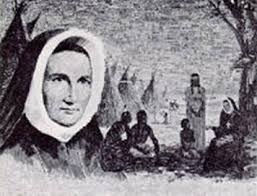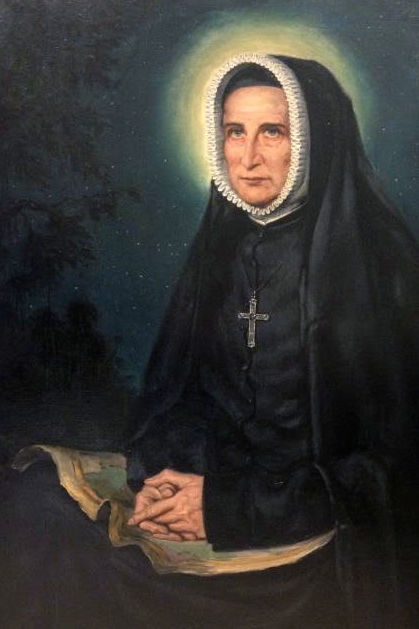The Catholic Defender: How The West Was Won, St. Rose Philippine Duchesne
- Donald Hartley

- Nov 20, 2024
- 7 min read

I love to share the history of the Old West, the conversion of Buffalo Bill, Sitting Bull, and Doc Holiday are amazing stories. On November 18th, the, the Universal Catholic Church celebrates the life of Saint Rose Philippine Duchesne.
St. Rose was born in Grenoble (1769), France from wealthy parents who developed a love of politics from an early age. Her father was very involved with the politics of the time and her mother held a strong Catholic dedication to the poor.
That is a special combination that through her many battles worked out a great Saint.
At age 19, St. Rose joined a religious order during the horror of the French Revolution that closed her convent.
St. Rose work to help the poor continued above ground, while at the same time, she supported priests serving underground at the risk of her own life. St. Rose loved children opening a school for homeless boys and girls.
With the religious order demolished by the evil taking place in France, St. Rose led four religious nuns joining a new order, the Society of the Sacred Heart. St. Madeleine Sophie Barat, the founder, would become close friends with St. Rose. This relationship only advanced the ambition of St. Rose of going to the New World. How she began to yearn serving the American Indians that she was learning about in Louisiana.

Finally, at age 49, in 1818, St. Rose made the break for America. With four nuns, St. Rose was able to charter a ship heading for the United States sailing for 11 weeks with much anticipation and uncertainty.
The Sisters first landed in New Orleans and made their way up the Mississippi to St. Louis.
Upon reporting to the local Bishop, he sent the Sisters to St. Charles, Missouri, which at that time was a disappointment for the Sisters.
Their dream was to work among the Indians. St. Rose set up the first free school for girls west of the Mississippi, but with virtually no support, it became a battle for survival as they weathered the cold and hunger.
Closing shop the Sisters made their way to Florissant Missouri where St. Rose founded the first Catholic Indian school.
The Sisters found the hard life living on the American frontier an everyday challenge. There was always the threat of Indian attacks as the land was yet untamed, there was always concerns where and when the next meal would come from, water, housing, expenses and even forest fires threatened them.
The children also were not easy to handle living on the frontier, St. Rose, at age 72, founded a mission at Sugar Creek Kansas among the Potawatomi Indians, (I would eventually be born in Sugar Creek Missouri as I grew up among the Potawatomi and Kickapoo Indians). The little band of four nuns and three priests boarded a Missouri River steamboat on June 29, 1841 and headed for Kansas.

Upon arriving in Kansas, she was welcomed by 500 Indians in their ceremonial attire, St. Rose writes, “On reaching here, we were greatly disappointed to find no house ready for us, and we showed our distress... When the steamboat passage was paid, we had scarcely $20 left. The pastor has given us two fine cows and put at our service a pair of oxen, a good horse, and charette [wagon]. It will be easy to plant a nice vegetable garden. We brought with us the Negro man from St. Louis. He is a carpenter and will help with the manual work. Our baggage has not arrived yet.”
In 1842, St. Rose wrote her sister, “Congress forced the Potawatomi to move into this region and will pay them an annual sum of money which, as long as the arrangement lasts, will save them from dire misery. This year we have seen them making good use of part of their money by buying shoes, shirts, and other articles of clothing, such as the white people wear. But the blanket is always an important item in their dress. Christianity changes these unfortunate people so noticeably that a pagan among them can always be identified by his fierce and unkempt appearance. In our school some dear little girls are beginning to read in their own language and some in English also. More than 20 have learned to spin quite well. They are, on the whole, very interesting children, but they find it very difficult to stay at the same work for any length of time.”

St. Rose wrote of what she witnessed among her work among the Indians, she writes, “I want to add also a few more lines about our good Potawatomi. The Catholic Indians live in a village quite separate from the pagans, who honor the evil spirit in order to ward off harm. Among the Catholics there is no drunkenness, no dancing, no gambling. Every Sunday one sees at least a hundred at the Holy Table; at Christmas 400 received the sacraments. Since last July about 70 old people have been baptized, and they are all persevering. In the church the men and women sit on opposite sides and sing hymns in their own language. They do this also at night and they say the family rosary, each one carrying a pair of beads always...”
St. Madeleine Sophie Barat sent an envoy from France to see how St. Rose had progressed, Sister Elizabeth Galitzin gave this report:

“She is here just to suffer, for she has aged much in this short time and is sometimes like a little child. She no longer has the fine mind of other days. She is feeble; her limbs are swollen; her digestion is poor. I fear she will have a stroke. To tell the truth we cannot understand how the Father Superior could have insisted on bringing her here. But he said that she would pray for the missions...All she can do at present is pray, sometimes lying for a little while on her bed, and knit stockings.”
Writing to Sister Barat, St. Rose said, "From the Tribe and Village of the Potawatomi. There are no difficulties here except when people worry too much about tomorrow. This tribe, which like many others was driven out of Michigan [and Indiana] by the Americans, is now about half Catholic.”
Of her work among the Indian children, St. Rose wrote:
“I left our Sisters at Sugar Creek in good health... A little five-room house had been built for us before I left. Many of the children had learned to read, knit, card wool, and spin. Some already knew how to sew when we went there, and they like this kind of work best of all...”
The Indians named St. Rose, "Woman-Who-Prays-Always" (Quah-kah-Ka-num-ad) and there is the testimony that Indian children once sneaked up behind her as she prayed and sprinkled paper bits on her habit. Several hours later, upon coming back to find the paper bits undisturbed.
St. Rose served this mission for only one year, the Indians grew to love her where she died on November 18, 1852.

St. Rose, the holy servant of the Lord was beatified by Pope Pius XII in 1940 and canonized by St. Pope John Paul II in 1988.
"For so the Lord has commanded us, saying, 'I have set you to be a light for the Gentiles, that you may bring salvation to the uttermost parts of the earth." Acts 13:47
"Therefore, since we are surrounded by so great a cloud of witnesses, let us also lay aside every weight, and sin which clings so closely, and let us run with perseverance the race that is set before us, looking to Jesus the pioneer and perfecter of our faith, who for the joy that was set before him endured the cross, despising the shame, and is seated at the right hand of the throne of God. Consider him who endured from sinners such hostility against himself, so that you may not grow weary or fainthearted." Hebrews 12:1-3
We cultivate a very small field for Christ, but we love it, knowing that God does not require great achievements but a heart that holds back nothing for self…. The truest crosses are those we do not choose ourselves…. He who has Jesus has everything. (St. Rose Philippine Duchesne)
St. Rose Philippine Duchesne was born in France in 1769. She had six sisters and one brother.
As a child, Rose contracted smallpox. She survived the disease, but she was scarred from it for the rest of her life.
When Rose was twelve years old, her family sent her and a cousin to study in a monastery. She began to feel strongly attracted to living the monastic life, but her father did not wish this for her so he removed her from the monastery school.
When Rose was nineteen, she decided to disregard her family’s objections and enter a religious order called the Visitation of Holy Mary. But in 1792 as the French Revolution raged, her monastery was closed. Rose returned to her family’s home in the country.
Two of her aunts living at her family’s home were also nuns who had been expelled from their monasteries. Rose tried to continue living out her order’s rule faithfully while ministering to those suffering from the Reign of Terror.
In 1801 when Napoleon’s reign allowed the Church to operate publically again, Rose tried to re-establish her monastery. But the buildings were in severe disrepair after having been used as a prison and a military barracks. Most of the nuns were elderly and unable to continue living in those conditions.
Around the same time, Madeleine-Sophie Barat established a new religious order called the Society of the Sacred Heart. She offered to merge Rose’s floundering Visitation order with this new order. The two orders shared the mission of educating young women, and neither order was an enclosed religious order. Roes accepted the offer to merge her order with the Society of the Sacred Heart.
When Rose was forty-nine years old, she felt called to serve the Native Americans in the United States. She requested permission to serve as a missionary in the United States. She traveled to the United State with four other sisters.
Rose and her companions established a boarding school near St. Louis for the settlers’ daughters. She and her companions also established the first free school in the area west of the Missouri River.
When Rose was seventy-one years old, she established a school for Native Americans. They called her “the woman who is always praying.”
Throughout her years in the United States, Rose continually showed great courage in facing the difficult conditions of frontier life. She also held steadfast to her calling of serving the Native American people.
St. Rose Philippine Duchesne Feast Day: November 18th





















Comments